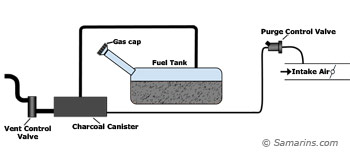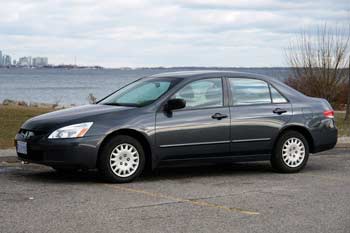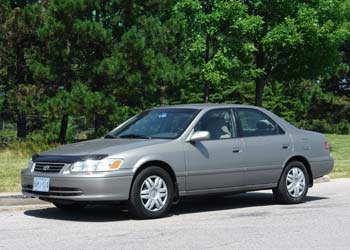P0442 EVAP System Leak Detected (Small Leak): causes, symptoms, diagnostic
The purpose of the EVAP System is to prevent fuel vapors inside the fuel tank from releasing in to the atmosphere. Read how the EVAP system works below.The EVAP System is sealed. As you drive and conditions allow, the engine computer (PCM) tests the EVAP system for leaks by monitoring pressure or vacuum inside the system. The code P0442 indicates that the engine computer (PCM) has detected a small leak in the EVAP system.
Symptoms:
With this code there might be no symptoms other than the Check Engine light. In some cases, you might notice a faint gasoline smell when the car is parked in a garage. In some cars, the warning about fuel cap being loose may also appear on the dash. If the problem is caused by blockage in the EVAP vent valve or hose, the car might be difficult to fill with gas.Common causes:
- faulty gas cap- rust on the fuel cap sealing surface of the fuel filler neck
- faulty vent valve solenoid (canister close valve)
- leaking purge valve (solenoid)
- damaged or cracked charcoal canister
- cracked EVAP line or ripped EVAP rubber hose
- rust damage of the fuel tank, filler neck or EVAP hose
How the code p0442 is diagnosed:
Many automotive shops and dealers have a special device called "smoke machine" to test the EVAP system for leaks. To run the EVAP system leak test, the mechanics also use an advanced scan tool that can operate the components of the EVAP system and monitor the pressure or vacuum inside the fuel tank. Without testing equipment, diagnosing the code P0442 is difficult. However, we know that the three most common culprits for the code P0442 are the fuel cap, the vent valve and the purge valve (solenoid).The fuel cap needs to be inspected for cracks in the seal and other damage. If rust coming out of the fuel cap, or the fuel cap seal looks damaged, the cap must be replaced. The fuel cap sealing surface on the filler neck needs to be inspected for corrosion.
The purge valve controls the flow of the vapors into the engine. The purge valve is normally closed. It can also be tested separately. Read more about the EVAP purge valve. A crack in one of the EVAP hoses or lines or in the EVAP canister can also cause a small leak, but without testing equipment finding a small crack is very difficult.
Common problems causing the code P0442
According to the GM service bulletin, in some 2011-2013 Chevy, Buick and Cadillac vehicles the code P0442 might be caused by the leaking EVAP Vent Solenoid (CVS). The vent solenoid must be tested under vacuum and replaced if leaking.Another GM service bulletin 02-06-04-037J for Chevy Silverado / GMC Sierra recommends replacing the vent valve solenoid assembly and adding or relocating a filter box using a service kit, if the code P0442 and other EVAP-related codes are present. The vent valve draws fresh air into the EVAP system. The problem might be caused by dirt, dust getting into the vent and restricting the air flow. Water getting into the vent valve solenoid can cause corrosion and prevent the vent valve solenoid from sealing the system.
The Toyota service bulletin EG051-06 describes a problem with the 2003-2004 2WD Toyota Corolla and Matrix and the 2005 4WD Matrix. The corrosion of the fuel cap sealing surface on the fuel tank filler pipe can prevent a fuel cap from sealing properly. This could result in the code P0442 and other EVAP codes. The bulletin recommends inspecting the fuel cap sealing surface of the filler neck for corrosion. If the corrosion is found, the fuel tank filler pipe must be replaced with an updated part. The bulletin also tells to inspect the fuel cap O-ring for damage and replace the fuel cap if damage is present.
A leaking purge valve is a common cause of the code P0422 in some Mercedes, Hyundai, Nissan, Ford and Mazda vehicles. A purge valve (solenoid) is normally closed. It can be inspected with a vacuum pump. Read more about purge valve.
In some Mazda 5 minivans, the code P0442 could be caused by a leaking vent valve. The vent valve in Mazda 5 is located in the back of the car near the rear subframe.
How the EVAP system works
The EVAP system traps fuel vapors from the fuel tank and temporarily stores them in the charcoal canister. As you drive, the vapors are purged from the canister and burned in the engine. The engine computer can monitor the EVAP system pressure using the fuel tank pressure sensor.If the problem with the EVAP system is repaired and the code is not erased, it may take a few days of driving before the Check Engine light is reset. This is because the EVAP system self-test (monitor) runs only in certain driving conditions.


